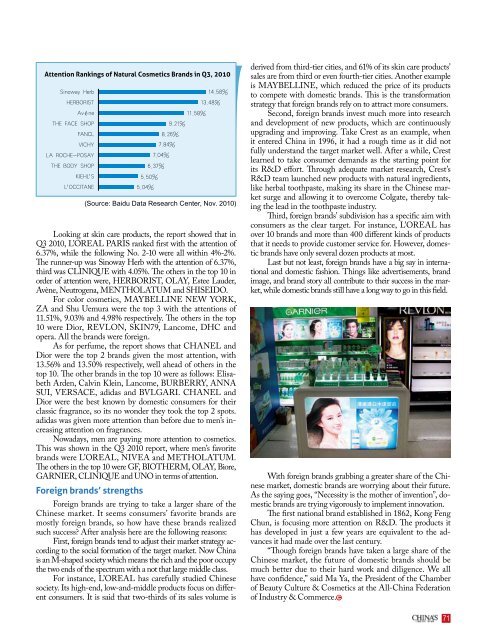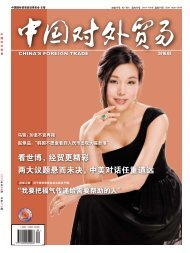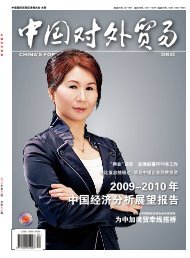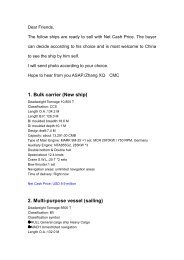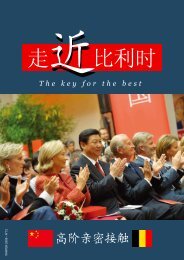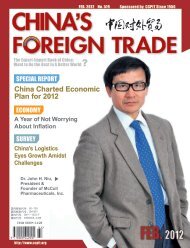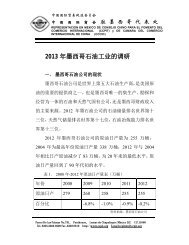Create successful ePaper yourself
Turn your PDF publications into a flip-book with our unique Google optimized e-Paper software.
Attention Rankings of Natural Cosmetics Brands in Q3, 2010<br />
Sinoway Herb<br />
HERBORIST<br />
Avène<br />
THE FACE SHOP<br />
FANCL<br />
VICHY<br />
LA ROCHE-POSAY<br />
THE BODY SHOP<br />
KI EH L'S<br />
L'OCCITANE<br />
9.21%<br />
8.26%<br />
7.84%<br />
7.04%<br />
6.37%<br />
5.50%<br />
5.04%<br />
11.58%<br />
14.58%<br />
13.48%<br />
(Source: Baidu Data Research Center, Nov. 2010)<br />
Looking at skin care products, the report showed that in<br />
Q3 2010, L’OREAL PARIS ranked first with the attention of<br />
6.37%, while the following No. 2-10 were all within 4%-2%.<br />
The runner-up was Sinoway Herb with the attention of 6.37%,<br />
third was CLINIQUE with 4.05%. The others in the top 10 in<br />
order of attention were, HERBORIST, OLAY, Estee Lauder,<br />
Avène, Neutrogena, MENTHOLATUM and SHISEIDO.<br />
For color cosmetics, MAYBELLINE NEW YORK,<br />
ZA and Shu Uemura were the top 3 with the attentions of<br />
11.51%, 9.03% and 4.98% respectively. The others in the top<br />
10 were Dior, REVLON, SKIN79, Lancome, DHC and<br />
opera. All the brands were foreign.<br />
As for perfume, the report shows that CHANEL and<br />
Dior were the top 2 brands given the most attention, with<br />
13.56% and 13.50% respectively, well ahead of others in the<br />
top 10. The other brands in the top 10 were as follows: Elisabeth<br />
Arden, Calvin Klein, Lancome, BURBERRY, ANNA<br />
SUI, VERSACE, adidas and BVLGARI. CHANEL and<br />
Dior were the best known by domestic consumers for their<br />
classic fragrance, so its no wonder they took the top 2 spots.<br />
adidas was given more attention than before due to men’s increasing<br />
attention on fragrances.<br />
Nowadays, men are paying more attention to cosmetics.<br />
This was shown in the Q3 2010 report, where men’s favorite<br />
brands were L’OREAL, NIVEA and METHOLATUM.<br />
The others in the top 10 were GF, BIOTHERM, OLAY, Biore,<br />
GARNIER, CLINIQUE and UNO in terms of attention.<br />
Foreign brands’ strengths<br />
Foreign brands are trying to take a larger share of the<br />
Chinese market. It seems consumers’ favorite brands are<br />
mostly foreign brands, so how have these brands realized<br />
such success? After analysis here are the following reasons:<br />
First, foreign brands tend to adjust their market strategy according<br />
to the social formation of the target market. Now China<br />
is an M-shaped society which means the rich and the poor occupy<br />
the two ends of the spectrum with a not that large middle class.<br />
For instance, L’OREAL has carefully studied Chinese<br />
society. Its high-end, low-and-middle products focus on different<br />
consumers. It is said that two-thirds of its sales volume is<br />
derived from third-tier cities, and 61% of its skin care products’<br />
sales are from third or even fourth-tier cities. Another example<br />
is Maybelline, which reduced the price of its products<br />
to compete with domestic brands. This is the transformation<br />
strategy that foreign brands rely on to attract more consumers.<br />
Second, foreign brands invest much more into research<br />
and development of new products, which are continuously<br />
upgrading and improving. Take Crest as an example, when<br />
it entered China in 1996, it had a rough time as it did not<br />
fully understand the target market well. After a while, Crest<br />
learned to take consumer demands as the starting point for<br />
its R&D effort. Through adequate market research, Crest’s<br />
R&D team launched new products with natural ingredients,<br />
like herbal toothpaste, making its share in the Chinese market<br />
surge and allowing it to overcome Colgate, thereby taking<br />
the lead in the toothpaste industry.<br />
Third, foreign brands’ subdivision has a specific aim with<br />
consumers as the clear target. For instance, L’OREAL has<br />
over 10 brands and more than 400 different kinds of products<br />
that it needs to provide customer service for. However, domestic<br />
brands have only several dozen products at most.<br />
Last but not least, foreign brands have a big say in international<br />
and domestic fashion. Things like advertisements, brand<br />
image, and brand story all contribute to their success in the market,<br />
while domestic brands still have a long way to go in this field.<br />
With foreign brands grabbing a greater share of the Chinese<br />
market, domestic brands are worrying about their future.<br />
As the saying goes, “Necessity is the mother of invention”, domestic<br />
brands are trying vigorously to implement innovation.<br />
The first national brand established in 1862, Kong Feng<br />
Chun, is focusing more attention on R&D. The products it<br />
has developed in just a few years are equivalent to the advances<br />
it had made over the last century.<br />
“Though foreign brands have taken a large share of the<br />
Chinese market, the future of domestic brands should be<br />
much better due to their hard work and diligence. We all<br />
have confidence,” said Ma Ya, the President of the Chamber<br />
of Beauty Culture & Cosmetics at the All-China Federation<br />
of Industry & Commerce.<br />
71


